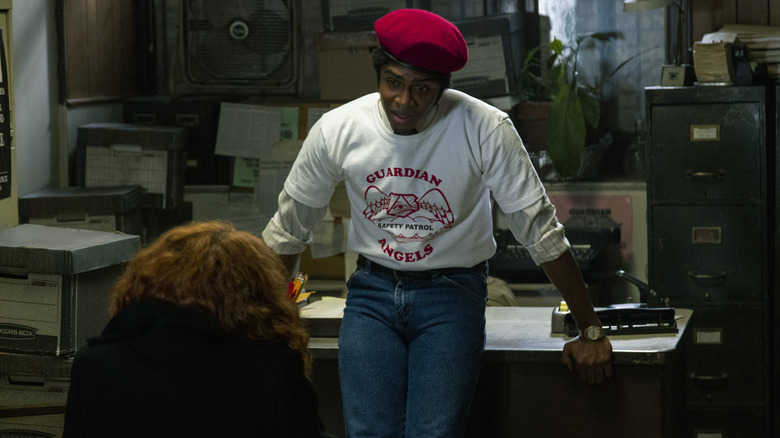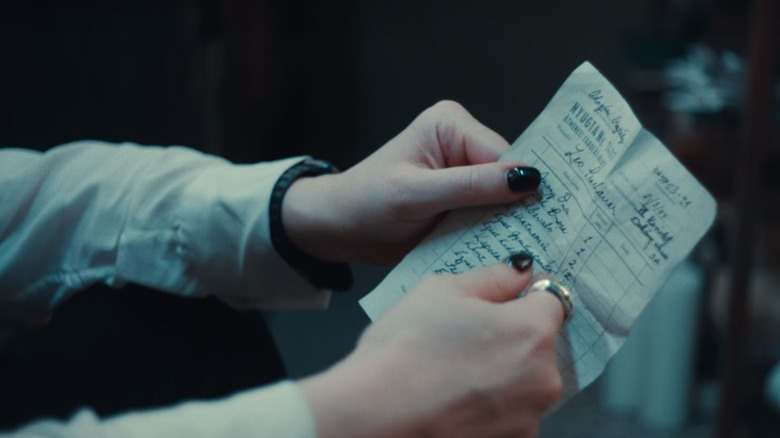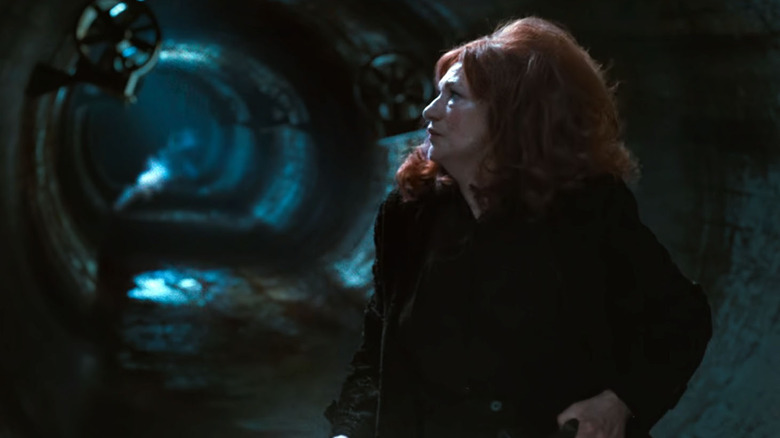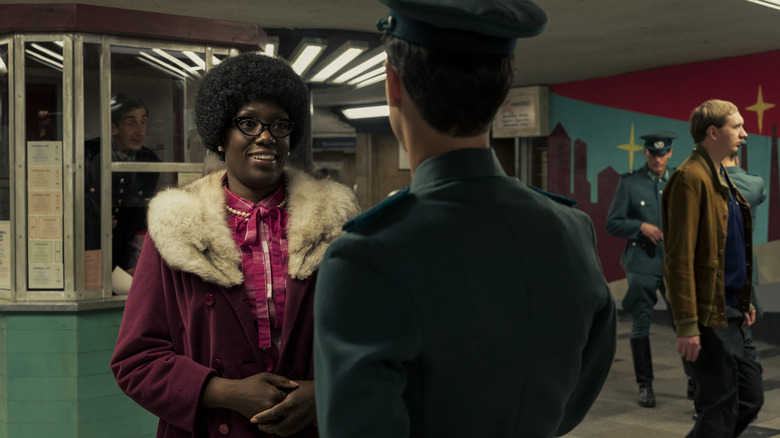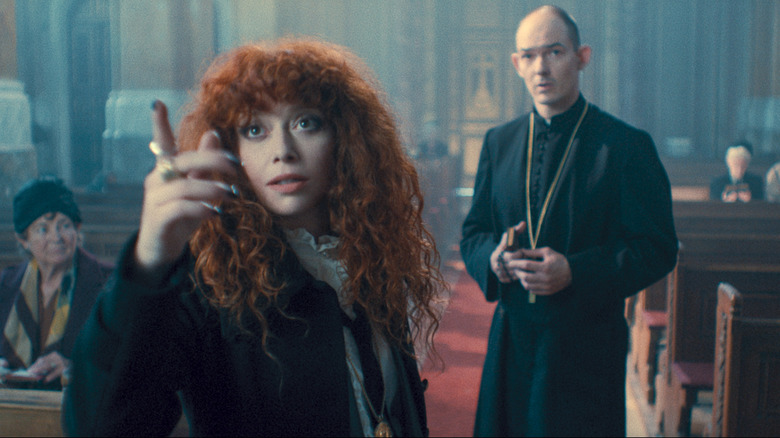How Much Of Russian Doll Season 2 Is A True Story?
Content warning: This piece digs into the history of Europe during World War II, including the events of the Holocaust. Reader discretion is advised.
Season 1 of the Netflix series "Russian Doll" had fun with a time-loop à la "Groundhog Day," but season 2 ups the ante with some good old fashioned time travel, made possible through the magic of the New York subway's 6 train.
Throughout the season, Nadia (Natasha Lyonne) and Alan (Charlie Barnett) travel through time to try and find peace in their present-day realities. They end up in several different periods throughout history, and while their journey to get there may be fantastical, many of their experiences are based in fact. So, how much of "Russian Doll" season 2 is historically accurate, and how much is fictionalized to tell a more interesting story? It turns out the truth, in some cases, can be just as wild as the fiction it inspires.
Major spoilers for "Russian Doll" season 2 ahead.
Who were the Guardian Angels?
When Nadia ends up in her pregnant mother's body in 1982, it comes as a pretty massive shock (especially since she's pregnant with herself). One of the first signs that she's traveled through time is the presence of Guardian Angels, wearing the distinctive uniform of a red beret and a shirt with a weird Illuminati-looking pyramid eye logo on the front. While the Angels are working in New York City once more, there was a time where their presence had faded and they were thought of as a late 1970s/early 1980s relic.
The Guardian Angels were founded by Curtis Sliwa in 1979, with thirteen original members that helped patrol the city's dangerous subways. The Guardian Angels were a volunteer force and were required to abide by strict rules and regulations regarding their conduct on the trains and subway platforms, including a no weapons policy. The primary goal of the Guardian Angels was to patrol the subways and help prevent assaults, sexual harassment, and robberies, which is why the first time Nadia sees them, they're chasing after a purse-snatcher on the subway platform. One Guardian Angel, Derek (Ephraim Sykes) stops to help her, seeing that she's pregnant, and tries to offer her an escort home because, well, the streets of New York were not exactly the safest place in 1982.
Later, Nadia seeks out the Guardian Angels in the hope that they can help her find Chez (Sharlto Copley), her mother's former lover, who stole the family's fortune. She assumes that the Angels can help her track him down, but that's really not what they do, and Derek even tells her as much. The Angels are protectors, using citizen's arrests to bring offenders to the police and offering self-defense training, but they aren't private detectives by any stretch of the imagination. The Guardian Angels have come under scrutiny over the years, mostly from the police force, though some citizens also raised concerns for the safety of the Angels themselves after one was killed in the line of duty in 1982, right around the time that Nadia is walking around New York in her mother's body.
These days, in addition to stopping violent crimes and thefts on the subways, the Angels have an all-female division called the Perv Busters, who call out and sometimes detain sexual predators on the trains, taking them to police. Many of the Guardian Angels of today have taken over for family members of past generations — like one young member of the Perv Busters who wears her grandmother's red beret. Throughout "Russian Doll" season 2, Nadia is reminded that even in terrible times, there are people willing to help. In the 1980s in New York, the best representation of humanity's guardian angels was the Guardian Angels.
Was there really a Hungarian Gold Train?
After losing her family's fortune once more on the 6 train on her way back from the 1980s, Nadia decides to trace the loss back to the very beginning. She and her friend Maxine (Greta Lee) travel to Budapest to try and unravel the mystery behind the "Hungarian gold train," where Nadia believes that her family's belongings were taken by the Nazis and then redistributed among gentiles. She eventually ends up going back through time into her grandmother Vera's body in 1944, at the height of the Nazi occupation of Hungary. As she exits the train she's stopped by a friend of Vera's, dressed as a Christian widow in mourning gear, who tells her not to reveal her heritage or she'll end up on the next train (to a concentration camp). When Nadia/Vera tries to protest, the woman reminds her that if she's not careful, she'll "end up like her mother," and we discover that Vera's mother was taken away to the camps and she was never heard from again.
Soon Nadia runs into Vera's best friend, Delia, who is also dressed as a widow in an effort to avoid detection by the Nazis. There are many stories of Jewish people "hiding in plain sight" during the Nazi occupation of Europe, and this is just one way they might have tried to avoid being singled out. People were taken by the Nazis for being Jewish, Romani, mentally ill, or homosexual, and being taken often meant a horrific death. Approximately 600,000 Hungarian Jews were killed in the Holocaust, so the threat was extremely real. Nadia, however, knows that her grandmother will survive long after World War II, so her only concern is finding the gold train and her family's stolen belongings.
So was there a Hungarian Gold Train? Yes. Not only did it exist, but the United States military intercepted it in 1945 and had full receipts for the items inside. However, instead of attempting to return the stolen items to the Hungarian people, the United States just sort of took all that insane wealth for itself. There were promises to restore it to refugees who were displaced by or survived the Holocaust, but instead, U.S. military personnel serving in Austria, like Major General Harry J. Collins, "inherited" the riches for their own homes. Post-WWII, the warehouse where the items were stored was opened to the public for sale — similar to the sale of stolen goods and the giant warehouse that Nadia discovers in Budapest. This is one part of "Russian Doll" that is sadly very true, and calls for reparations and returning items to the descendants of the original owners have still only been met with half-measures.
What happened to Hungary after World War II?
Hungary was actually aligned with Germany for much of World War II, as Nazi occupation made cooperation seem like an easier route for government officials. The Hungarian government generally worked with the Nazis and even sent their armies to fight against the Soviet Union, though they suffered heavy losses.
In December 1944, Soviet forces were able to free Hungary from Nazi occupation and the country officially declared war on Germany. Eventually they signed the Armistice with the Allied Forces, and ended up as a satellite state of the Soviet Union. As Hungary tried to reconcile the horrors exacted upon its own people and began trials for war crimes, communist beliefs began to take hold among the population. Soviet control grew stronger until 1956, when the Hungarian people attempted a revolution, which was frustrated by Stalin's control. But although the Soviets crushed the uprising, they never regained the same control over the Hungarian government or its people.
In 1968, when Vera goes back to Budapest to find her buried treasure, things were still a bit chaotic in Eastern Europe. Hungary had gained some autonomy from the USSR, but the Soviets invaded neighboring Czechoslovakia (which is now two nations: Czechia and Slovakia) in 1968. The goal was a full takeover of the nation, also a satellite state of the USSR, in response to the protests and liberalizing reforms referred to as the Prague Spring. The Hungarian government and its people had to be very careful to not incur the same kind of wrath, so it's really no surprise that Vera hightails it back to New York as soon as she gets her buried belongings.
What are Krugerrands, exactly?
After Nadia (in Vera's body) manages to get her family's stolen stuff back from their underground hiding place decades after the war, she returns to New York with her best friend Delia (Athina Papadimitriu), who encourages her to exchange the valuables for Krugerrands, which she believes are the most stable form of currency. Gold, after all, usually maintains value, and South African Krugerrands, first minted in 1967, were considered the ideal standard for preserving a fortune in 1968, when Vera traded for them.
At the time, Krugerrands were the only readily available one ounce gold coin, making them preferable for the collector that wasn't wealthy enough to buy gold bullion in bars or other, larger forms. The United States banned the import of Krugerrands in 1985 as worldwide awareness of South African apartheid policies grew, though the coins remained legal to own as long as you weren't bringing them into the country. (The import ban has since been lifted.)
The price of a single troy ounce of gold, which is what a Krugerrand contains, hovered around $40 in 1968. Vera's 150 Krugerrands would have been worth approximately $6000. Adjusting for inflation, that's almost $50,000. The cost of a 1968 Krugerrand today hovers around $3,000 — higher than some other Krugerrands because fewer coins were minted that year. If Nadia still had all 150 Krugerrands and sold them in 2022, she would be looking at a fortune of close to $450,000. That's quite a chunk of change, so it's little wonder that Nadia wanted to get those coins back!
Tunneling under the Berlin Wall
While Nadia bounces all over time, Alan only really travels back to one specific place and time: East Berlin, 1962. He ends up in the body of his grandmother, Agnes (Carolyn Michelle Smith), a graduate student from Ghana. She (and Alan by proxy) are having a little romance with a German student named Lenny (Sandor Funtek). Alan is very much in love and learning some things about himself when he discovers that Lenny and a group of other students are going to tunnel beneath the Berlin Wall in order to get to their relatives in democratic West Berlin.
East Berlin, still under Soviet rule, is a harsh place, but Alan finds a lot to love there as long as Lenny is around. Unfortunately, Lenny doesn't want to listen to Alan's request to wait until the wall falls in 1989; even if he did believe that Agnes somehow has knowledge of the future, he's not willing to wait 27 years to see his family again. Alan eventually loses track of Lenny when the students dig their tunnel and escape, and he's left heartbroken.
Tunnels beneath the Berlin wall were very real indeed, and the story depicted in "Russian Doll" is fairly close to the true story of Tunnel 57. In 1963, a group of West German university students, along with one Eastern German who had escaped years before, decided to dig a tunnel beneath the Berlin wall to help people escape from East Berlin. They were caught by the Soviet police on their first attempt and some served jail time, but they tried again and were successful in October of 1964. The majority of the tunnels were dug from the west to the east, with helpers on both sides to help usher people to freedom. Tunnel 57 earned its name because 57 East Berliners were able to escape through it in just two days, comprising nearly one-fifth of all successful tunnel escapes during the existence of the wall.
Some of these impressive tunnels still exist today, and one from 1970 is now a tourist attraction open to the public.
How autobiographical is Russian Doll?
"Russian Doll" isn't just based in history; it's also partly based on season 2 showrunner and star Natasha Lyonne's personal history. There are numerous connections to her life and family, including having a grandmother who was a Holocaust survivor from Hungary, but she used those details to create a more complex fictional Nadia instead of just recreating them wholesale. In an interview with LA Times, Lyonne explained that while there is inspiration from her own life, the series is in no way autobiographical:
"What I am drawing on is a more holistic, philosophical or even spiritual worldview — that's the personal part of the show. Yes, my grandmother was also a Holocaust survivor, that is true. But no, my grandmother has nothing to do with Vera, and no, my grandmother doesn't dress like that or act like that. She didn't have those conversations with my mom, and no, she never put my mom in a mental hospital in the '80s. And no, my mom was not pregnant with me when this happened."
Lyonne wanted to explore generational trauma through empathy, and the best way to do that was by literally putting Nadia in her mother and grandmother's shoes. Nadia is nearing her 40th birthday and is trying to reconcile who she is before Ruth, the last person who has known her since her childhood, dies. She feels completely adrift without her ancestors to anchor her — both her blood relatives and her chosen family. Lyonne found the concept universally relatable, because we never really know what our parents or grandparents went through without our own context. As we age, we gain the ability to understand them more, even if we don't have the incredible tool of a time-traveling 6 train to help us get there.
There is one character in "Russian Doll" that Lyonne pulled from her reality, and it's adoptive mother figure Ruth. While there are differences between the two Ruths, Lyonne's description of the one in her life has a lot in common with her no-nonsense TV counterpart:
"There is a real Ruth in my life and she definitely said, 'The only thing easy in this life is pissing in the shower.' She also said, 'Jersey — it's free to get in, but you got to pay to get out.' My Ruth is a chemist, this Ruth is a shrink. So they're quite different. But the essence of the idea of like, in Manhattan, you can scramble through a whole hectic day of being a troublemaker and then just show up at some safe haven and there's chicken in the fridge; that's definitely a direct pull from my life."
The second season of this incredible series is only made better by the historical and personal aspects added to it, making it feel more relevant and resonant than ever. There's really no telling where things might go in season 3, but hopefully the series maintains this level of emotional depth and willingness to dig deep into the tough stuff.
"Russian Doll" season 2 is now streaming on Netflix.

